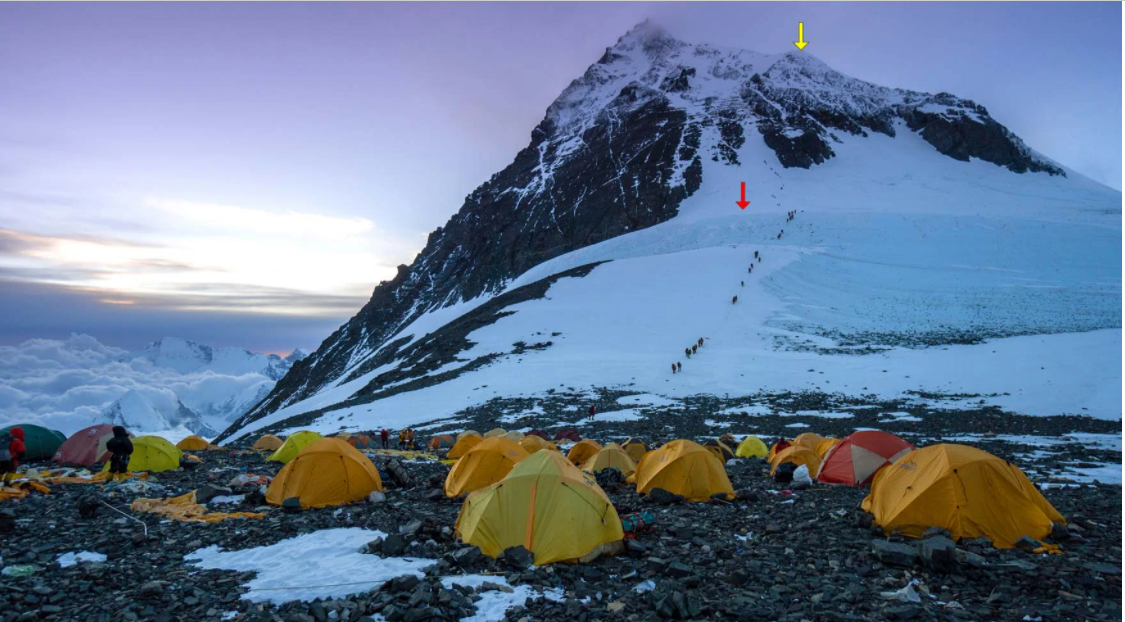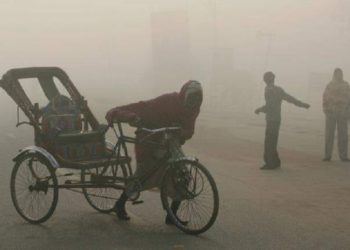KATHMANDU: Melting on Mount Everest’s highest glacier is occurring at an alarming pace, according to a new study by researchers from the University of Maine, published in the peer-reviewed academic periodical Nature Portfolio Journal Climate and Atmospheric Science.
The team’s findings suggested that ice that had taken decades to accumulate was melting away each year, jeopardizing both climbers and those who depend on the glacier for drinking water and irrigation.
Though studies on the impacts of climate change are common, little work has been done on the melting of mountain glaciers in the highest parts of the world.
The researchers found that the South Col Glacier has lost 180 feet of thickness in the last 25 years — meaning it melted over 80 times faster than the 2,000 years it took to form the top layer of the glacier. The team blamed warming air temperatures, loss of humidity, and strong winds.
A team of scientists and climbers, including six from the University of Maine, visited the glacier in 2019 and collected samples from a 10-meter-long (around 32 feet) ice core.

The research showed that once the glacier’s ice became exposed, it lost around 55 meters (180 feet) of ice in a quarter-century.
The researchers note that the glacier has transformed from consisting of snowpack into predominantly ice, and that change could have started as early as the 1950s. But the ice loss has been most intense since the late 1990s.
This transformation to ice means the glacier can no longer reflect radiation from the sun, making its melt more rapid.
A liaison officer assigned to Mt Everest Gyanendra Shrestha said the thickness of deposited snow and ice is weathering away thereby reducing its volume. Every year, the level of snow is coming down.
It is for everybody to see even from the base camp, he points out. He has experienced an unexpected turn in the weather conditions of Himalayan mountains led to the outburst of glacier lakes reducing the volume of locked ice present there. There are more than 50 glacier lakes in the Everest Base Camp and at a higher altitude.
Model simulations show that because of the extreme exposure to solar radiation, melting or vaporization in this region can speed up by a factor of more than 20, once snow cover transforms to ice. A drop in relative humidity levels and stronger winds are also factors.
In addition to all the impacts on those who depend on water from glaciers, the current rate of melt would also make expeditions on Mount Everest more challenging, as snow and ice cover thin further over coming decades, the study said.
While glacier melt is widely studied, little scientific attention has been paid to glaciers at the highest points of the planet, the researchers argue in the study.
Lhakpa Gelbu Sherpa, who climbed Mt Everest from the Northern (Tibet) 10 times and from the Southern (Nepal) side 6 times said, “On the northern side, there is a pile of ice till Camp II. After Camp II, you hardly find the ice and should walk on the black rock. “On the Southern side as well the layers of ice is diminishing every year. From Camp IV, you find the rock.” Sherpa said to Khabarhub.
By studying the ice core, taken from the South Col Glacier, as well as data from weather stations and satellite imagery, the researchers found that effects of climate change had not just reached the top of the highest mountain in the world, but had significantly altered its landscape in the last two decades. Crucially, the researchers found that the South Col Glacier has lost its snowpack — a thick covering of snow over the hard ice of the glacier — which accelerated the melting process.

“It answers one of the big questions posed by our 2019 NGS/Rolex Mount Everest Expedition — whether the highest glaciers on the planet are impacted by human-sourced climate change. The answer is a resounding yes, and very significantly since the late 1990s,” Paul Mayewski, expedition leader and director of UMaine’s Climate Change Institute, said in the release.
The researchers also warned that the loss of the glacier ice could lead to significantly more exposed bedrock, which could make Mount Everest climbing expeditions more dangerous in the decades to come.
“Climate predictions for the Himalaya suggest continued warming and continued glacier mass loss, and even the top of the Everest is impacted,” added Mariusz Potocki, a glaciochemist who collected the ice core.
The fact that Mount Everest is melting is, in and of itself, nothing new. Indeed, the retreat of mountain glaciers worldwide are well documented, though Mount Everest itself isn’t fully understood in terms of weather, climate, and glacier health at its highest peaks.
“In fact, climbing Everest has become tougher due to global warming,” Mingma David Sherpa, who all the 14 peaks above 8000 meters said adding, “The Khumbu Icefall is melting faster due to global warming.”
Unfortunately, it is the climbers who litter the mountains since garbage started piling up since the first successful attempt to conquer Everest in 1953.
Besides dead bodies, garbage on Everest includes food packages, can bins, oxygen cylinders, cooking gas, tents, and human poo, among others.
Despite the majestic spell Everest still casts from a distance, it is getting less charming to the climbers due to pollution.
According to the Everest Summiteers Association, which has, in recent years, taken tons of debris off the mountain, there are still about 30 tons of trash left on the mountain.

Everest has so much garbage — depleted oxygen cylinders, food packaging, rope — that climbers use the trash as a kind of signpost. Moreover, the tents are littering South Col, or Camp 4, which, at 8,000 meters (26,240 feet) is the highest campsite on Everest, just below the summit. The high winds at that elevation have scattered the tents and trash everywhere.
And these findings, as noted by Paul Mayewski, a glaciologist, and director of the University of Maine’s Climate Change Institute and who led the expedition, confirm that the situation on Everest isn’t good, and it’s our fault.
“One of the big questions posed by our [expedition was] whether the highest glaciers on the planet are impacted by human-sourced climate change,” Mayewski explained in a statement.
“The answer is a resounding yes, and very significantly since the late 1990s.”
The South Col Glacier’s ice has been exposed due to less snow covering it. Rather, instead of snow, it’s ice. This is an issue, because snow absorbs sunlight radiation more, which in turn leads to more melting.
Sanu Sherpa, the third Nepali to climb all 14 peaks above 8,000 meters dubbed the decreasing volume of snow in the mountains makes him thoughtful about the fate of the Sherpa’s as the primary victim and the rest of the community living in different parts of the world as the secondary victims. To him, the excessive heat caused by global warming seems to be ripping the lives of many people dependent on mountains.
There are a few major implications. For people who just see Mount Everest as a mountain to climb, the current changes could spell bad news.
As Mayewski and his co-author Mariusz Potocki explained, the rapid decline of the glaciers could see there being less snow and ice to climb over. Instead, climbers will come face to face with exposed bedrock that they will have to overcome.
Mountain glaciers are an important source of water. In fact, many people depend on mountain glaciers for freshwater.
Over 1 billion people rely on the Himalayan mountains like Everest glaciers for freshwater. That’s around 12.8% of the global population.
To illustrate the sheer magnitude, more people rely on Himalayan mountain glaciers for water than the entire population of North America or Europe.
If the South Col Glacier is declining, that could eventually spell trouble for all the people who rely on it for water. And this goes for other mountain glaciers as well.
“Everest’s highest glacier has served as a sentinel for this delicate balance and has demonstrated that even the roof of the Earth is impacted” by man-made climate change, the study notes.
(With inputs from CNN, Nature, Jerusalem Post and Agencies)









Comment